Development and Application of a Water and Salt Balance Model for Well-Canal Conjunctive Irrigation in Semiarid Areas with Shallow Water Tables
Abstract
:1. Introduction
2. Materials and Methods
2.1. Model Development
2.1.1. Groundwater Balance Module
- Groundwater balance in the well-canal conjunctive irrigation area
- 2.
- Water exchange between canal- and well-irrigated areas
2.1.2. Root Zone Salt Balance Module
2.2. Model Verification and Application
2.2.1. Case 1: Synthetic Virtual Case for the Model Verification and Sensitivity Analysis
- 1.
- Model verification
- 2.
- Model sensitivity analysis
2.2.2. Case 2: Synthetic Case for the Parameter Value Rule
2.2.3. Case 3: Practical Application in an Arid Agricultural District
- 1.
- Study site
- 2.
- Settings of the water-saving irrigation scenario
2.3. Model Evaluation Indexes
3. Results and Discussion
3.1. Model Accuracy of the Groundwater Balance Module
3.2. Model Sensitivity Analysis
3.3. Description of the Lc Parameter Value
3.4. Model Calibration and Validation in the Longsheng Well-Canal Conjunctive Irrigation District
3.4.1. Model Calibration
3.4.2. Model Validation
3.5. Long-Term Predictions of Soil Salinity Dynamics under Present and Future Water-Saving Conditions
3.5.1. Prediction Results under Present Conditions
3.5.2. Prediction Results Obtained under Future Water-Saving Conditions
4. Conclusions
- (1)
- The developed model can reasonably reflect the dynamics of groundwater and soil salinity in the root zone under well-canal conjunctive irrigation conditions, and the special parameter Lc in the model is not insensitive.
- (2)
- The soil salinity of the study area can be maintained at a low level under current conditions. Besides for water-saving conditions, the autumn irrigation amount for canal- and well-irrigated areas can decrease by 17.5 mm and 22.2 mm, respectively, with a 0.1 m increase in water table depth to maintain the soil salinity at a mild level, while an increase by 101.7 mm with a 1.0 kg/m3 groundwater concentration increase can occur in the well-irrigated area.
- (3)
- To effectively control soil salinization, the water table depth should be controlled at a suitable depth. For the canal-irrigated area, sufficient water for soil salt leaching should be guaranteed, while for the well-irrigated area, it is recommended to exploit groundwater with lower salt concentration.
- (4)
- The model is limited to regional-scale and large time discretization soil salinity prediction.
Author Contributions
Funding
Data Availability Statement
Conflicts of Interest
References
- Kulmatov, R.; Khasanov, S.; Odilov, S.; Li, F. Assessment of the Space-Time Dynamics of Soil Salinity in Irrigated Areas under Climate Change: A Case Study in Sirdarya Province, Uzbekistan. Water Air Soil Pollut. 2021, 232, 216. [Google Scholar] [CrossRef]
- Rengasamy, P. World salinization with emphasis on Australia. J. Exp. Bot. 2006, 57, 1017–1023. [Google Scholar] [CrossRef] [PubMed] [Green Version]
- Fei, W.; Zhou, S.; Asim, B.; Shengtian, Y.; Jianli, D. Multi-algorithm comparison for predicting soil salinity. Geoderma 2019, 365, 114211. [Google Scholar]
- Hassani, A.; Azapagic, A.; Shokri, N. Predicting long-term dynamics of soil salinity and sodicity on a global scale. Proc. Natl. Acad. Sci. USA 2020, 117, 33017–33027. [Google Scholar] [CrossRef] [PubMed]
- Ali, R.; Elliott, R.L.; Ayars, J.E.; Stevens, E.W. Soil Salinity Modeling over Shallow Water Tables. I: Validation of LEACHC. J. Irrig. Drain. Eng. 2000, 126, 223–233. [Google Scholar] [CrossRef]
- Ali, R.; Elliott, R.L.; Ayars, J.E.; Stevens, E.W. Soil Salinity Modeling over Shallow Water Tables. II: Application of LEACHC. J. Irrig. Drain. Eng. 2000, 126, 234–242. [Google Scholar] [CrossRef]
- Yu, R.; Liu, T.; Xu, Y.; Zhu, C.; Zhang, Q.; Qu, Z.; Liu, X.; Li, C. Analysis of salinization dynamics by remote sensing in Hetao Irrigation District of North China. Agric. Water Manag. 2010, 97, 1952–1960. [Google Scholar] [CrossRef]
- Xu, X.; Huang, G.; Qu, Z.; Pereira, L.S. Assessing the groundwater dynamics and impacts of water saving in the Hetao Irrigation District, Yellow River basin. Agric. Water Manag. 2010, 98, 301–313. [Google Scholar] [CrossRef]
- Ren, D.; Xu, X.; Hao, Y.; Huang, G. Modeling and assessing field irrigation water use in a canal system of Hetao, upper Yellow River basin: Application to maize, sunflower and watermelon. J. Hydrol. 2016, 532, 122–139. [Google Scholar] [CrossRef]
- Loescher, W.; Chan, Z.; Grumet, R. Options for Developing Salt-tolerant Crops. HortScience 2011, 46, 1085–1092. [Google Scholar] [CrossRef] [Green Version]
- Cheng, Y.; Lee, C.-H.; Tan, Y.-C.; Yeh, H.-F. An optimal water allocation for an irrigation district in Pingtung County, Taiwan. Irrig. Drain. 2009, 58, 287–306. [Google Scholar] [CrossRef]
- Bredehoeft, J.D.; Young, R.A. Conjunctive use of groundwater and surface water for irrigated agriculture: Risk aversion. Water Resour. Res. 1983, 19, 1111–1121. [Google Scholar] [CrossRef]
- Li, P.; Qian, H.; Wu, J. Conjunctive use of groundwater and surface water to reduce soil salinization in the Yinchuan Plain, North-West China. Int. J. Water Resour. Dev. 2018, 34, 337–353. [Google Scholar] [CrossRef]
- Chang, L.-C.; Ho, C.-C.; Yeh, M.-S.; Yang, C.-C. An Integrating Approach for Conjunctive-Use Planning of Surface and Subsurface Water System. Water Resour. Manag. 2011, 25, 59–78. [Google Scholar] [CrossRef]
- Mani, A.; Tsai, F.T.-C.; Kao, S.-C.; Naz, B.; Ashfaq, M.; Rastogi, D. Conjunctive management of surface and groundwater resources under projected future climate change scenarios. J. Hydrol. 2016, 540, 397–411. [Google Scholar] [CrossRef] [Green Version]
- Singh, A. Conjunctive use of water resources for sustainable irrigated agriculture. J. Hydrol. 2014, 519, 1688–1697. [Google Scholar] [CrossRef]
- Gleeson, T.; VanderSteen, J.; Sophocleous, M.A.; Taniguchi, M.; Alley, W.M.; Allen, D.; Zhou, Y. Groundwater sustainability strategies. Nat. Geosci. 2010, 3, 378–379. [Google Scholar] [CrossRef]
- Mao, W.; Yang, J.; Zhu, Y.; Ye, M.; Wu, J. Loosely coupled SaltMod for simulating groundwater and salt dynamics under well-canal conjunctive irrigation in semi-arid areas. Agric. Water Manag. 2017, 192, 209–220. [Google Scholar] [CrossRef]
- Yang, Y.; Yan, Z.; Wei, M.; Heng, D.; Ming, Y.; Jingwei, W.; Jinzhong, Y. Study on the Exploitation Scheme of Groundwater under Well-Canal Conjunctive Irrigation in Seasonally Freezing-Thawing Agricultural Areas. Water 2021, 13, 1384. [Google Scholar] [CrossRef]
- Yue, W.; Gao, H.; Chen, A. Study on conjunctive use of water resources in Hetao Irrigation District of Inner Mongolia based on GAMS simulation and optimization. South-to-North Water Transf. Water Sci. Technol. 2013, 11, 12–16. (In Chinese) [Google Scholar]
- Mao, W.; Yang, J.; Zhu, Y.; Ye, M.; Liu, Z.; Wu, J. An efficient soil water balance model based on hybrid numerical and statistical methods. J. Hydrol. 2018, 559, 721–735. [Google Scholar] [CrossRef]
- Karandish, F.; Šimůnek, J. A comparison of the HYDRUS (2D/3D) and SALTMED models to investigate the influence of various water-saving irrigation strategies on the maize water footprint. Agric. Water Manag. 2019, 213, 809–820. [Google Scholar] [CrossRef] [Green Version]
- Lyu, S.; Chen, W.; Wen, X.; Chang, A.C. Integration of HYDRUS-1D and MODFLOW for evaluating the dynamics of salts and nitrogen in groundwater under long-term reclaimed water irrigation. Irrig. Sci. 2019, 37, 35–47. [Google Scholar] [CrossRef]
- Hanson, B.; Hopmans, J.W.; Šimůnek, J. Leaching with Subsurface Drip Irrigation under Saline, Shallow Groundwater Conditions. Vadose Zone J. 2008, 7, 810–818. [Google Scholar] [CrossRef] [Green Version]
- Birgani, S.; Mohammadi, A.S.; Nasab, S.B. Evaluation of the SWAP model for simulation of soil salinity under condition using of saline irrigation water and maize cultivation. N. Y. Sci. J. 2015, 8, 19–24. [Google Scholar]
- Singh, R. Simulations on direct and cyclic use of saline waters for sustaining cotton–wheat in a semi-arid area of north-west India. Agric. Water Manag. 2004, 66, 153–162. [Google Scholar] [CrossRef]
- Kroes, J.G.; van Dam, J.C.; Bartholomeus, R.P.; Groenendijk, P.; Heinen, M.; Hendriks, R.; Mulder, H.M.; Supit, I.; van Walsum, P. SWAP Version 4; Theory Description and User Manual, Report 2780; Wageningen Environmental Research: Wageningen, The Netherlands, 2017. [Google Scholar]
- Zha, Y.; Yang, J.; Yin, L.; Zhang, Y.; Zeng, W.; Shi, L. A modified Picard iteration scheme for overcoming numerical difficulties of simulating infiltration into dry soil. J. Hydrol. 2017, 551, 56–69. [Google Scholar] [CrossRef]
- Remesan, R.; Prabhakaran, A.; Sangma, M.N.; Janardhanan, S.; Mainuddin, M.; Sarangi, S.K.; Mandal, U.K.; Burman, D.; Sarkar, S.; Mahanta, K.K. Modeling and Management Option Analysis for Saline Groundwater Drainage in a Deltaic Island. Sustainability 2021, 13, 6784. [Google Scholar] [CrossRef]
- Ranatunga, K.; Nation, E.; Barratt, D. Review of soil water models and their applications in Australia. Environ. Model. Softw. 2008, 23, 1182–1206. [Google Scholar] [CrossRef]
- Bouraoui, F.; Vachaud, G.; Haverkamp, R.; Normand, B. A distributed physical approach for surface-subsurface water transport modeling in agricultural watersheds. J. Hydrol. 1997, 203, 79–92. [Google Scholar] [CrossRef]
- Yu, M.; Rui, X. Application of water and salt balance model in Yinbei irrigation district of Ningxia. J. Hohai Univ. Nat. Sci. 2009, 37, 367–372. (In Chinese) [Google Scholar]
- Oosterbaan, R.J. SALTMOD: Description of Principles and Applications; ILRI: Wageningen, The Netherlands, 1998. [Google Scholar]
- Askri, B.; Bouhlila, R.; Job, J.O. Development and application of a conceptual hydrologic model to predict soil salinity within modern Tunisian oases. J. Hydrol. 2010, 380, 45–61. [Google Scholar] [CrossRef]
- Mainuddin, M.; Maniruzzaman, M.; Gaydon, D.; Sarkar, S.; Rahman, M.; Sarangi, S.; Sarker, K.; Kirby, J. A water and salt balance model for the polders and islands in the Ganges delta. J. Hydrol. 2020, 587, 125008. [Google Scholar] [CrossRef]
- Visconti, F.; De Paz, J.M.; Rubio, J.L.; Sánchez, J. SALTIRSOIL: A simulation model for the mid to long-term prediction of soil salinity in irrigated agriculture. Soil Use Manag. 2011, 27, 523–537. [Google Scholar] [CrossRef]
- Corwin, D.L.; Waggoner, B.L. TETRANS: Solute Transport Modeling Software User’s Guide; Macintosh Version 1.6. U.S. Salinity Laboratory Report 121; USDA-ARS U.S. Salinity Laboratory: Riverside, CA, USA, 1990; 92p.
- Sun, G.; Zhu, Y.; Ye, M.; Yang, J.; Qu, Z.; Mao, W.; Wu, J. Development and application of long-term root zone salt balance model for predicting soil salinity in arid shallow water table area. Agric. Water Manag. 2019, 213, 486–498. [Google Scholar] [CrossRef]
- Zhu, Y.; Shi, L.; Lin, L.; Yang, J.; Ye, M. A fully coupled numerical modeling for regional unsaturated–saturated water flow. J. Hydrol. 2012, 475, 188–203. [Google Scholar] [CrossRef]
- Welsh, W.D. Groundwater Balance Modelling with Darcy’s Law. Ph.D. Thesis, The Australian National University, Canberra, Australia, 2007. [Google Scholar]
- Kalbus, E.; Reinstorf, F.; Schirmer, M. Measuring methods for groundwater-surface water interactions: A review. Hydrol. Earth Syst. Sci. 2006, 10, 873–887. [Google Scholar] [CrossRef] [Green Version]
- Kuznetsov, M.; Yakirevich, A.; Pachepsky, Y.; Sorek, S.; Weisbrod, N. Quasi 3D modeling of water flow in vadose zone and groundwater. J. Hydrol. 2012, 450–451, 140–149. [Google Scholar] [CrossRef]
- Wang, Y.; Sun, Q.; Yang, Z. Analysis of regional-scale groundwater level changes before and after the implementation of water-saving project in the Hetao Irrigation District. Inner Mong. Water Resour. 2000, 3, 10–12. (In Chinese) [Google Scholar]
- Tong, W.-J.; Liu, Q.; Chen, F.; Wen, X.-Y.; Li, Z.-H.; Gao, H.-Y. Salt Tolerance of Wheat in Hetao Irrigation District and Its Ecological Adaptable Region. Acta Agron. Sin. 2012, 38, 909–913. [Google Scholar] [CrossRef]
- Schaake, J.; Liu, C. Development and application of simple water balance models to understand the relationship between climate and water resources. In New Directions for Surface Water Modeling; IAHS: Wallingford, UK, 1989; pp. 343–352. [Google Scholar]
- Yang, H.; Yang, D. Derivation of climate elasticity of runoff to assess the effects of climate change on annual runoff. Water Resour. Res. 2011, 47, W07526. [Google Scholar] [CrossRef]
- Pan, M. Study on the Water and Salt Balance Model in Well-Canal Combined Irrigated Area. Master’s Thesis, Wuhan University, Wuhan, China, 2016. [Google Scholar]
- Hao, P.J. Regional Water and Salt Regulation in Hetao Irrigation District after Combined Use of Surface Water and Groundwater with Drip Irrigation. Master’s Thesis, Wuhan University, Wuhan, China, 2016. (In Chinese). [Google Scholar]
- Tong, J.; Yang, J.; Yue, W.; Zhang, X. Simulative Study on Groundwater Evaporation Coefficient in Freezing and Thawing Period. J. Irrig. Drain. 2007, 26, 21–40. (In Chinese) [Google Scholar]
- Chen, Y.; Wang, S.; Gao, Z.; Guan, X.; Hu, Y. Effect of irrigation water mineralization on soil salinity based on SALTMOD model. J. Irrig. Drain. 2012, 31, 11–16. (In Chinese) [Google Scholar]
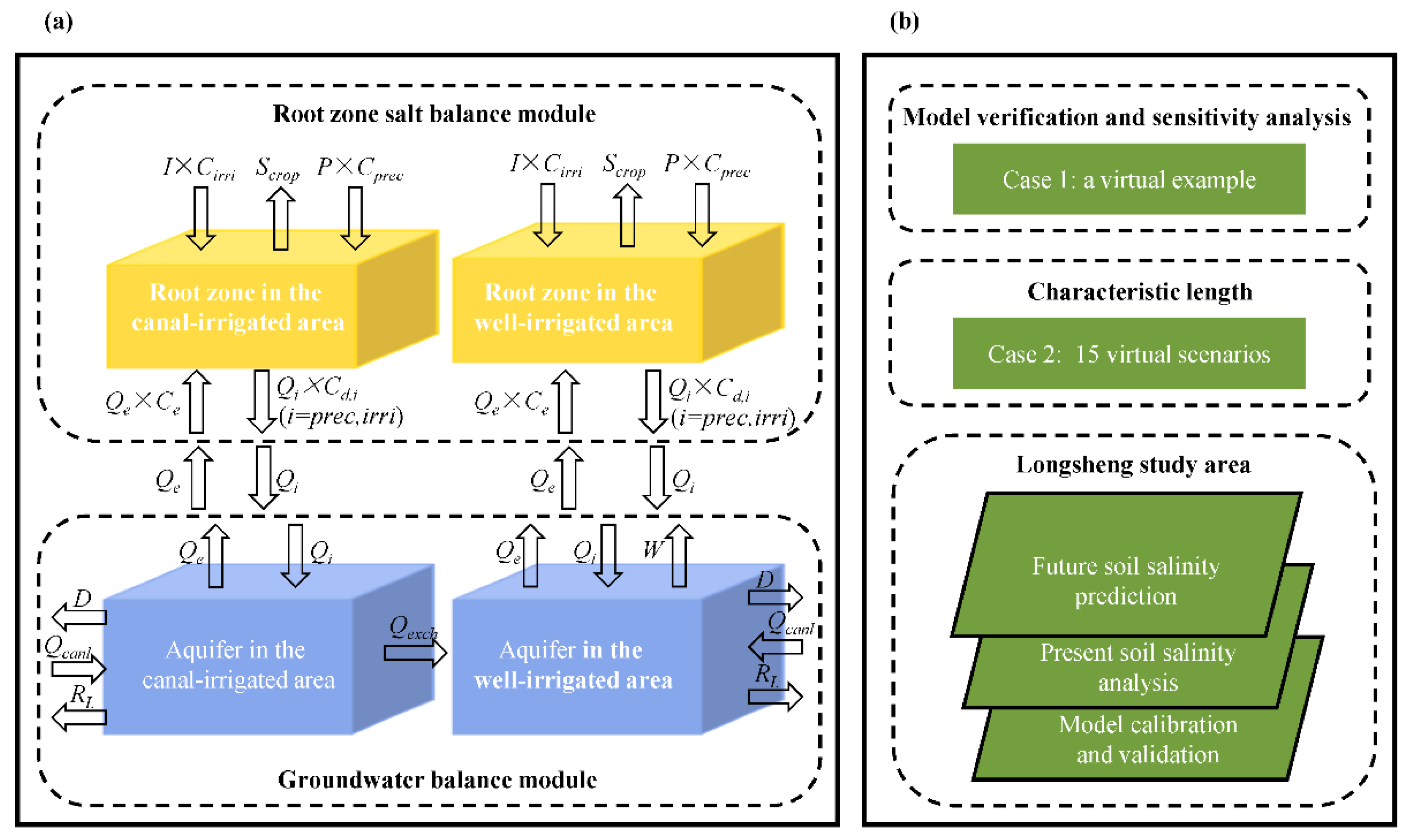


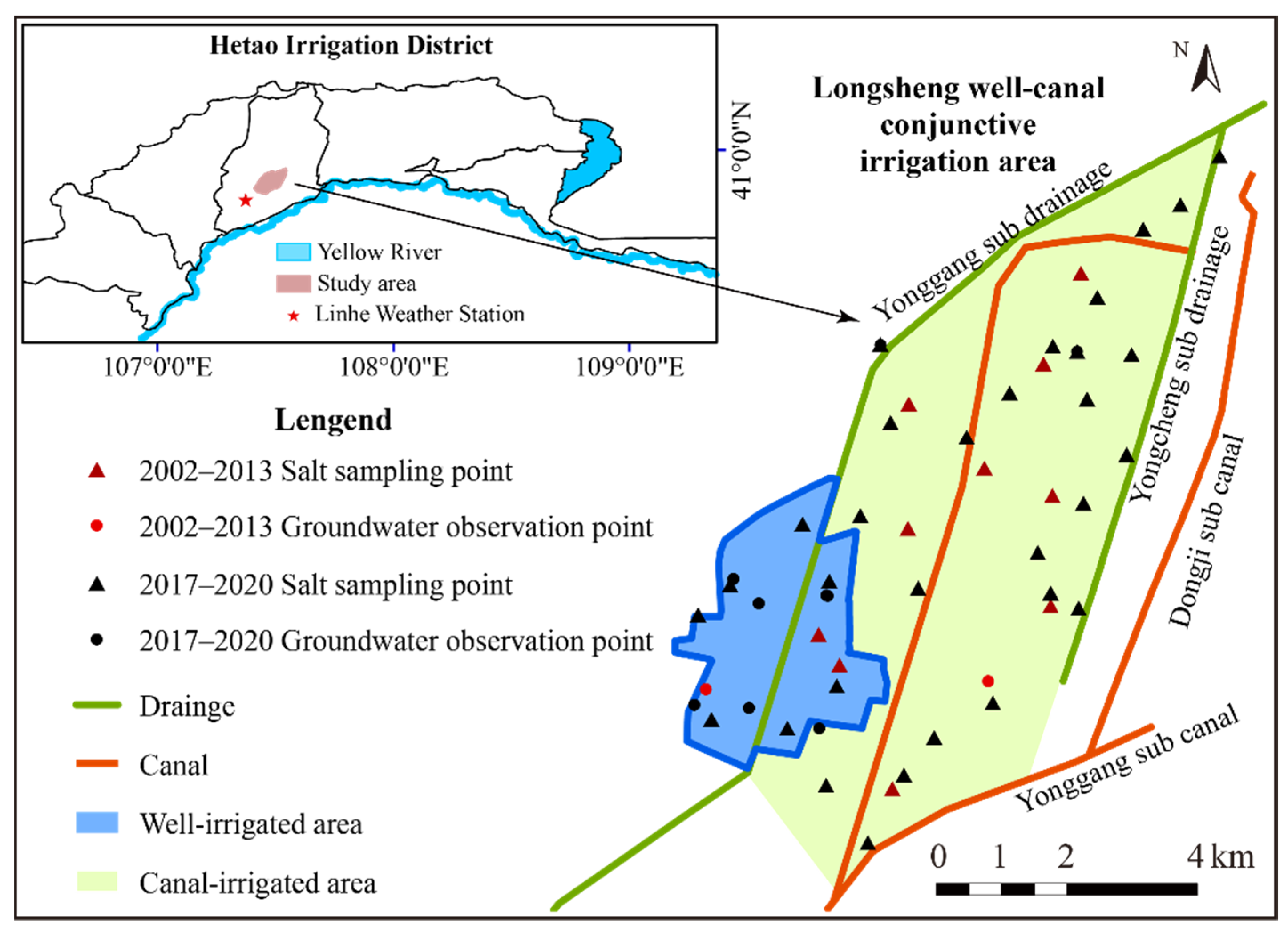
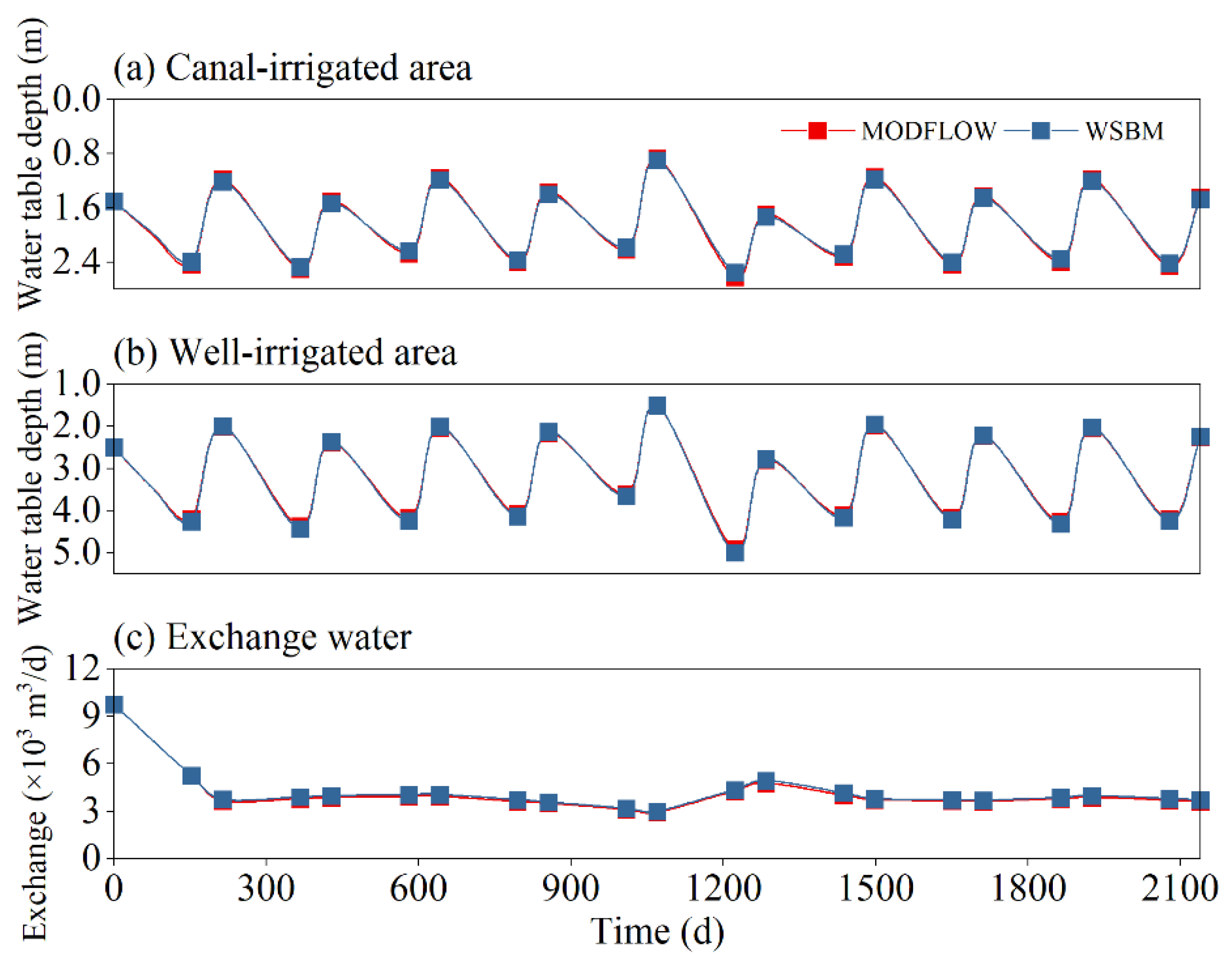
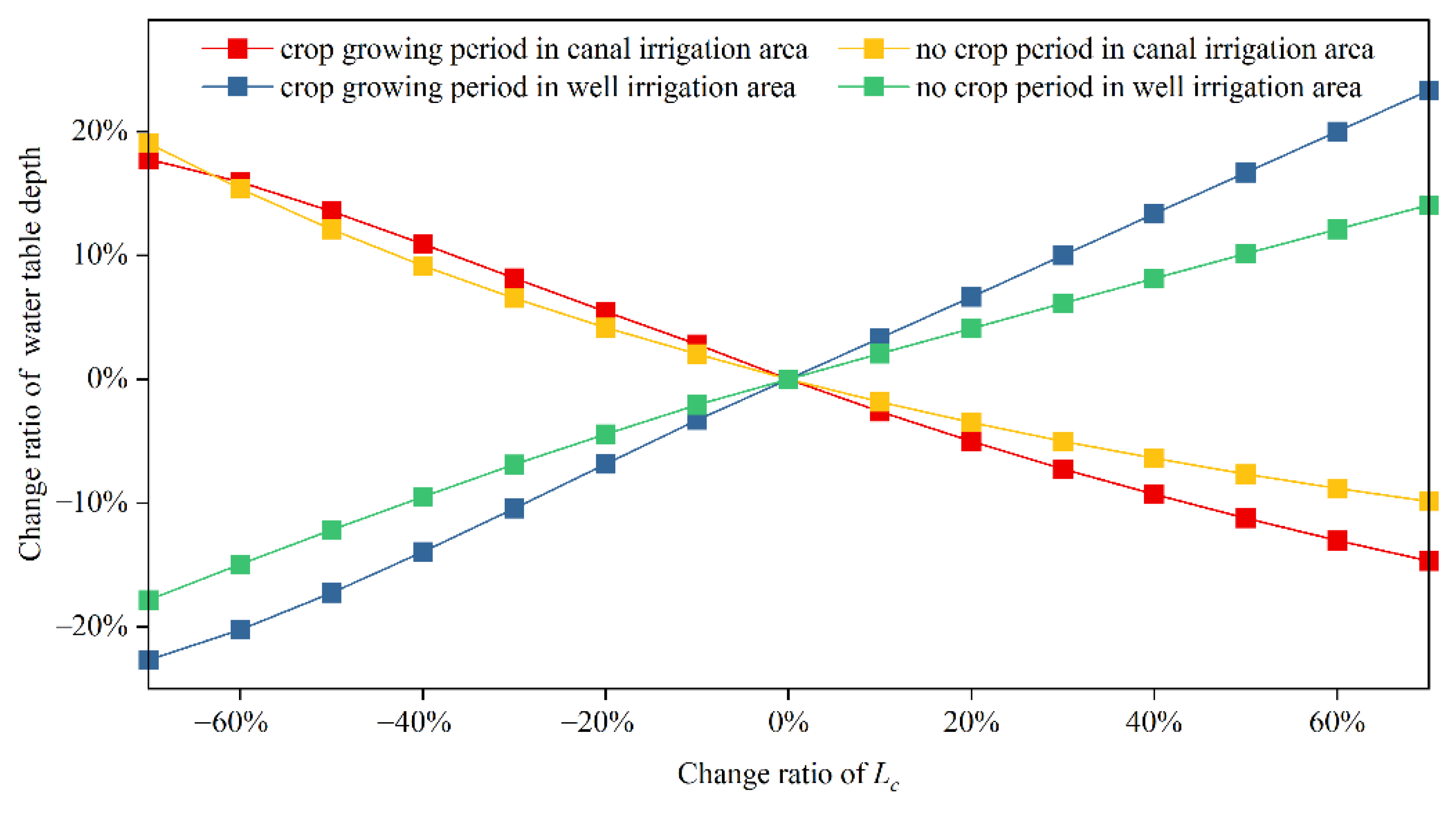
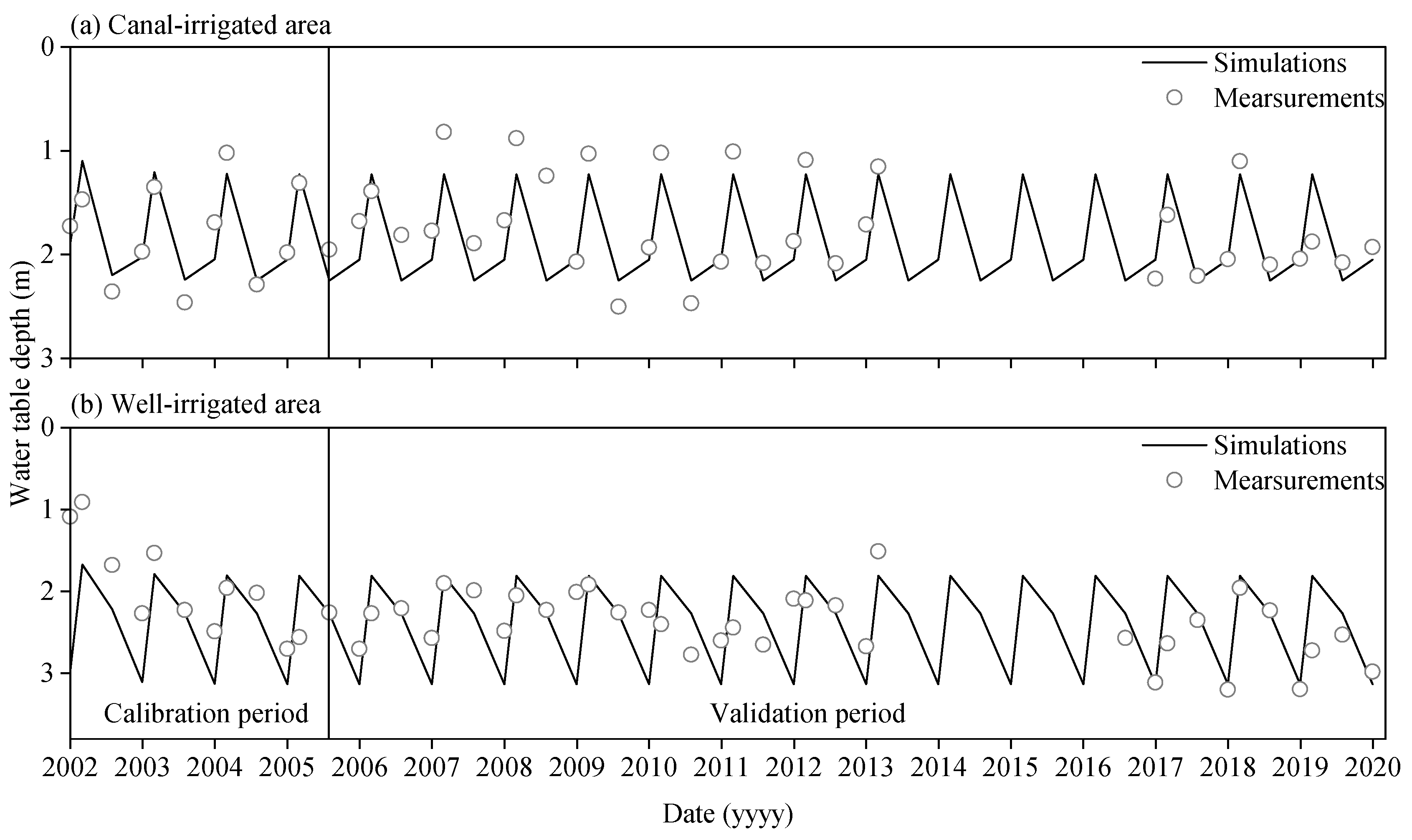


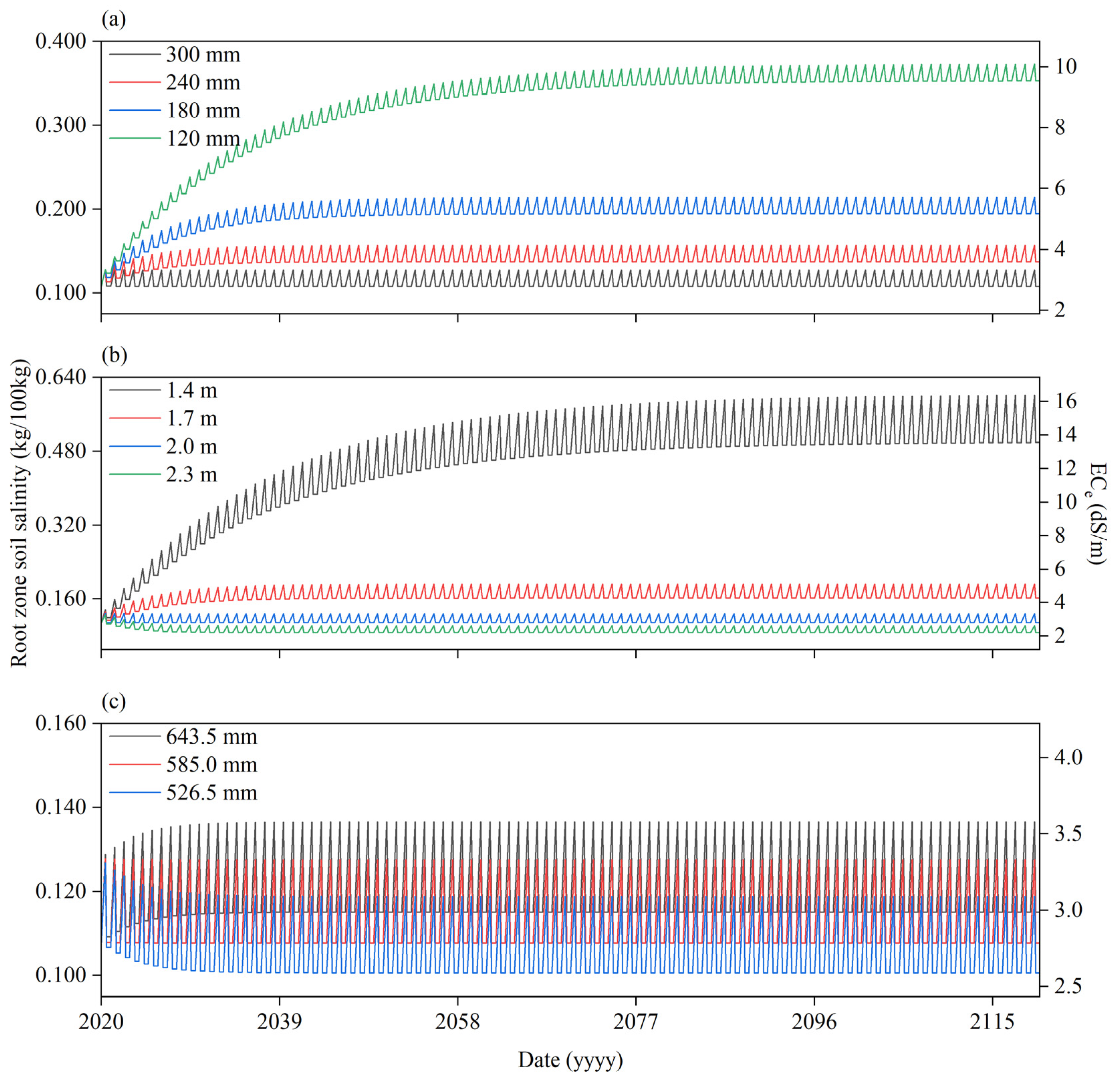


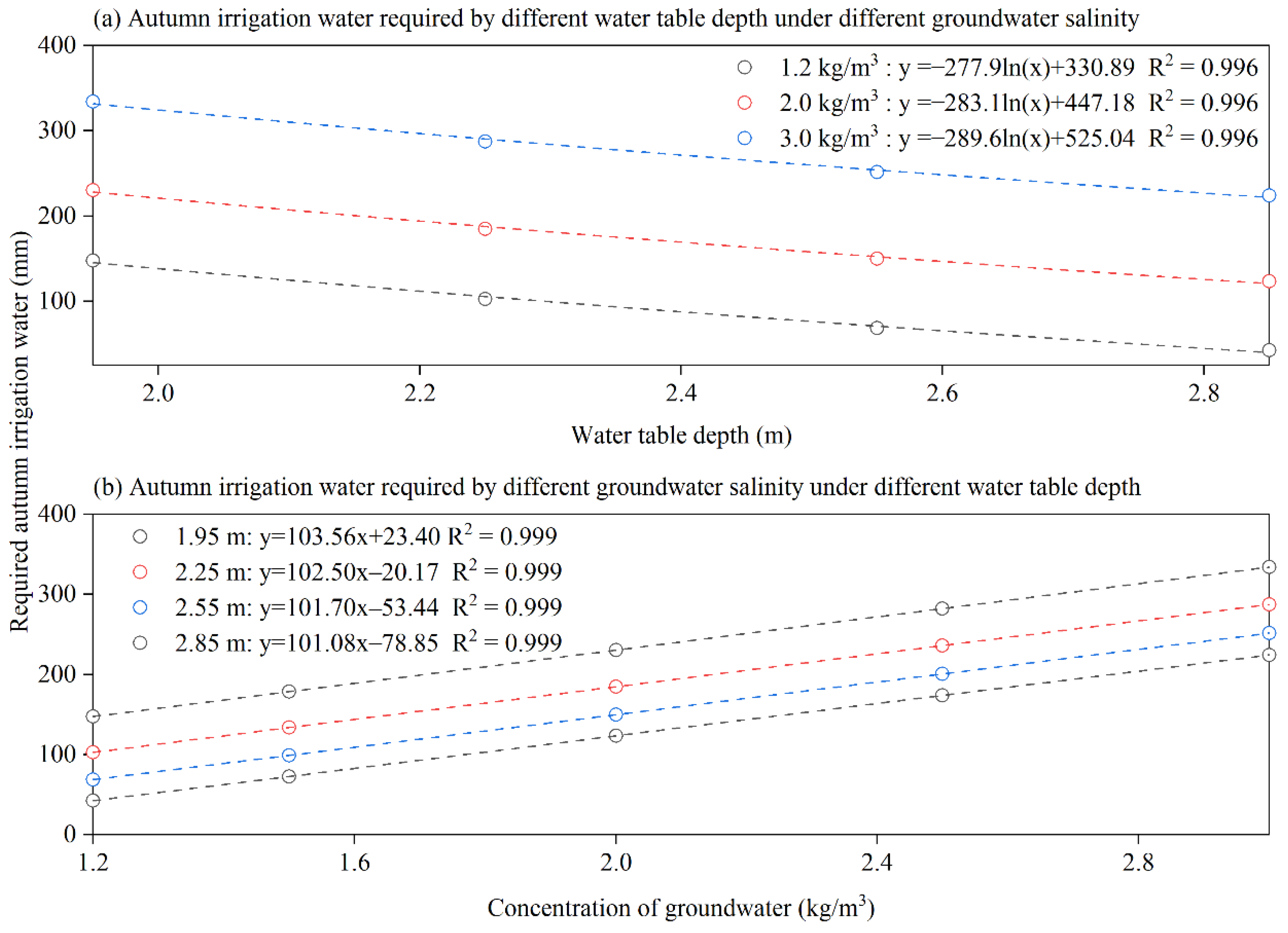
| Spatial Locations | Scenario No. | Sizes of Canal-Irrigated Area (×104 m2) | Sizes of Well-Irrigated Area (×104 m2) | Center Distance (m) | Lc (m) |
|---|---|---|---|---|---|
| Adjacent | A1 | 70 | 30 | 500 | 333 |
| A2 | 50 | 50 | 333 | ||
| A3 | 30 | 70 | 333 | ||
| A4 | 140 | 60 | 1000 | 667 | |
| A5 | 100 | 100 | 667 | ||
| A6 | 60 | 140 | 667 | ||
| A7 | 210 | 90 | 1500 | 1000 | |
| A8 | 150 | 150 | 1000 | ||
| A9 | 90 | 210 | 1000 | ||
| Central symmetry | A10 | 84 | 16 | 350 | 233 |
| A11 | 64 | 36 | 400 | 267 | |
| A12 | 36 | 64 | 450 | 300 | |
| A13 | 336 | 64 | 700 | 467 | |
| A14 | 256 | 144 | 800 | 533 | |
| A15 | 144 | 256 | 900 | 600 |
| Items | Scenario No. | Canal-Irrigated Area | Well-Irrigated Area |
|---|---|---|---|
| A. Irrigation quota in season 1 (mm) | S1 | 526.5 | 506.3 |
| S2 | 585.0 | 562.5 | |
| S3 | 643.5 | 618.8 | |
| B. Irrigation quota in season 2 (mm) | S4 | 300 | 300 |
| S5 | 240 | 240 | |
| S6 | 180 | 180 | |
| S7 | 120 | 120 | |
| C. Water table depth (m) | S8 | 1.4 | 1.95 |
| S9 | 1.7 | 2.25 | |
| S10 | 2.0 | 2.55 | |
| S11 | 2.3 | 2.85 | |
| S12 | 2.6 | 3.15 | |
| D. Groundwater salinity (kg/m3) | S13 | 0.64 | 1.2 |
| S14 | 2.0 | ||
| S15 | 3.0 |
| Scenario No. | Center Distance (m) | Lc (m) | Water Table Depth | |||||||
|---|---|---|---|---|---|---|---|---|---|---|
| Canal-Irrigated Area | Well-Irrigated Area | |||||||||
| R2 (-) | NRMSE (%) | MRE (%) | NSE (-) | R2 (-) | NRMSE (%) | MRE (%) | NSE (-) | |||
| A1 | 500 | 333 | 1.000 | 0.569 | 0.006 | 1.000 | 1.000 | 0.486 | 0.006 | 1.000 |
| A2 | 333 | 1.000 | 0.355 | 0.008 | 1.000 | 1.000 | 0.386 | 0.009 | 1.000 | |
| A3 | 333 | 1.000 | 1.923 | 0.083 | 0.995 | 1.000 | 1.799 | 0.080 | 0.995 | |
| A4 | 1000 | 667 | 1.000 | 0.794 | 0.008 | 1.000 | 1.000 | 1.947 | 0.030 | 0.999 |
| A5 | 667 | 1.000 | 1.073 | 0.017 | 0.999 | 1.000 | 0.727 | 0.019 | 1.000 | |
| A6 | 667 | 0.998 | 2.459 | 0.097 | 0.991 | 1.000 | 1.265 | 0.055 | 0.998 | |
| A7 | 1500 | 1000 | 0.999 | 3.426 | 0.035 | 0.995 | 1.000 | 3.360 | 0.063 | 0.995 |
| A8 | 1000 | 0.999 | 1.982 | 0.035 | 0.996 | 1.000 | 1.346 | 0.039 | 0.998 | |
| A9 | 1000 | 0.995 | 2.415 | 0.076 | 0.992 | 1.000 | 0.721 | 0.030 | 0.999 | |
| A10 | 350 | 233 | 0.999 | 4.111 | 0.032 | 0.996 | 0.999 | 4.387 | 0.041 | 0.996 |
| A11 | 400 | 267 | 1.000 | 0.419 | 0.006 | 1.000 | 1.000 | 1.082 | 0.015 | 0.999 |
| A12 | 450 | 300 | 0.999 | 2.191 | 0.071 | 0.994 | 0.999 | 2.433 | 0.083 | 0.991 |
| A13 | 700 | 467 | 0.999 | 4.081 | 0.030 | 0.996 | 0.999 | 3.641 | 0.033 | 0.997 |
| A14 | 800 | 533 | 1.000 | 0.964 | 0.013 | 1.000 | 1.000 | 2.657 | 0.036 | 0.997 |
| A15 | 900 | 600 | 0.998 | 1.879 | 0.056 | 0.995 | 0.999 | 2.772 | 0.097 | 0.989 |
| Item | Season | Canal-Irrigated Area | Well-Irrigated Area | ||||||||||
|---|---|---|---|---|---|---|---|---|---|---|---|---|---|
| Observation (m) | Simulation (m) | MRE (%) | NRMSE (%) | R2 (-) | NSE (-) | Observation (m) | Simulation (m) | MRE (%) | NRMSE (%) | R2 (-) | NSE (-) | ||
| Water table depth (m) | Season 1 | 1.84 | 2.00 | 8.74 | 8.70 | 0.20 | −0.24 | 2.14 | 3.09 | 44.38 | 44.39 | 0.99 | −0.11 |
| Season 2 | 1.29 | 1.19 | 7.87 | 15.50 | 0.47 | 0.19 | 1.74 | 1.77 | 1.74 | 27.59 | 0.75 | 0.65 | |
| Season 3 | 2.37 | 2.23 | 5.91 | 7.59 | 0.61 | 0.88 | 2.05 | 2.26 | 10.20 | 10.24 | 0.79 | 0.45 | |
| Annual | 1.97 | 1.96 | 7.43 | 9.14 | 0.79 | 0.42 | 2.03 | 2.52 | 23.03 | 27.59 | 0.87 | 0.32 | |
| ECe (dS/m) | Season 1 | 5.43 | 5.38 | 1.13 | 15.20 | 0.21 | 0.40 | 5.35 | 4.77 | 10.31 | 24.38 | 0.22 | 0.19 |
| Season 2 | 4.75 | 4.31 | 8.88 | 8.94 | 0.95 | −0.32 | 4.80 | 3.73 | 21.68 | 23.74 | 0.64 | −1.28 | |
| Season 3 | 5.93 | 4.53 | 23.14 | 22.97 | 0.95 | 0.63 | 4.17 | 3.92 | 5.96 | 13.29 | 0.97 | 0.44 | |
| Annual | 5.52 | 4.83 | 11.59 | 17.87 | 0.65 | 0.46 | 4.77 | 4.25 | 10.39 | 20.00 | 0.60 | 0.36 | |
| A. Groundwater balance | ||||||||||||||
| μ (-) | η (-) | λ (-) | Season 1 | Season 2 | Season 3 | Lc (m) | K (m/d) | |||||||
| αs1 (-) | εs1 (-) | ds1 (-) | αs2 (-) | εs2 (-) | ds2 (-) | αs3 (-) | εs3 (-) | ds3 (-) | cs3 (-) | |||||
| 0.10 | 0.17 | 0.12 | 0.15 | 0.6601 | 0.898 | 0.40 | 0.6601 | 0.898 | 0 | 2 | 1 | 0 | 1200 | 10 |
| B. Root zone salt balance | ||||||||||||||
| f (-) | θtc (cm3/cm3) | β (-) | ||||||||||||
| 0.80 | 0.28 | 0.99 | ||||||||||||
| Item | Season | Canal-Irrigated Area | Well-Irrigated Area | ||||||||||
|---|---|---|---|---|---|---|---|---|---|---|---|---|---|
| Observation (m) | Simulation (m) | MRE (%) | NRMSE (%) | R2 (-) | NSE (-) | Observation (m) | Simulation (m) | MRE (%) | NRMSE (%) | R2 (-) | NSE (-) | ||
| Water table depth (m) | Season 1 | 1.92 | 2.05 | 6.78 | 8.85 | 0.45 | 0.54 | 2.62 | 3.13 | 19.45 | 20.23 | 0.33 | 0.32 |
| Season 2 | 1.18 | 1.22 | 3.69 | 22.03 | 0.22 | 0.13 | 2.17 | 1.81 | 16.64 | 19.35 | 0.42 | 0.59 | |
| Season 3 | 2.13 | 2.25 | 5.73 | 14.08 | 0.43 | 0.67 | 2.36 | 2.27 | 3.78 | 8.05 | 0.56 | 0.47 | |
| Annual | 1.88 | 1.99 | 5.83 | 12.77 | 0.65 | 0.44 | 2.44 | 2.55 | 12.45 | 15.16 | 0.47 | 0.56 | |
| ECe (dS/m) | Season 1 | 3.26 | 3.32 | 2.06 | 11.20 | 0.36 | 0.25 | 3.48 | 3.34 | 3.45 | 12.78 | 0.38 | 0.29 |
| Season 2 | 2.96 | 2.79 | 5.38 | 20.18 | 0.26 | 0.02 | 3.51 | 2.68 | 22.89 | 30.60 | 0.27 | 0.15 | |
| Season 3 | 2.60 | 2.65 | 1.23 | 7.92 | 0.62 | 0.24 | 3.04 | 2.63 | 12.57 | 17.09 | 0.64 | 0.46 | |
| Annual | 2.93 | 2.96 | 2.27 | 11.50 | 0.68 | 0.21 | 3.29 | 2.93 | 10.49 | 17.46 | 0.52 | 0.33 | |
| Water Balance Items | Canal-Irrigated Area | Well-Irrigated Area | |||
| mm | Proportion (%) | mm | Proportion (%) | ||
| Iteams of inflow | Percolation from irrigation in season 1 | 55.35 | 21.03 | 36.45 | 8.56 |
| Percolation from irrigation in season 2 | 75.7 | 28.76 | 51.79 | 12.16 | |
| Seepage from canal system in season 1 | 75.58 | 28.71 | 49.77 | 11.68 | |
| Seepage from canal system in season 2 | 38.76 | 14.72 | 26.52 | 6.23 | |
| Percolation from precipitation | 17.86 | 6.78 | 17.86 | 4.19 | |
| Recharged exchange water | 0 | 0.00 | 243.61 | 57.19 | |
| Total recharge | 263.25 | 100.00 | 426.00 | 100.00 | |
| Iteams of outflow | Phreatic evaporation in season 1 and season 2 | 107.85 | 40.97 | 54.66 | 12.83 |
| Groundwater moving upward to the frozen layer in season 3 | 95.61 | 36.32 | 78.57 | 18.44 | |
| Discharged exchange water | 59.79 | 22.71 | 0.00 | 0.00 | |
| Pumping water | 0 | 0.00 | 292.76 | 68.72 | |
| Total discharge | 263.25 | 100.00 | 425.99 | 100.00 | |
| Salt Balance Items | Canal-Irrigated Area | Well-Irrigated Area | |||
| kg/m2 | Proportion (%) | kg/m2 | Proportion (%) | ||
| Iteams of inflow | Salt from irrigation in season 1 | 0.311 | 31.90 | 0.561 | 57.39 |
| Salt from irrigation in season 1 | 0.159 | 16.36 | 0.159 | 16.31 | |
| Salt from phreatic evaporation in season 1 | 0.405 | 41.60 | 0.206 | 21.09 | |
| Salt from phreatic evaporation in season 2 | 0.099 | 10.14 | 0.051 | 5.20 | |
| Total inflow | 0.974 | 100.00 | 0.977 | 100.00 | |
| Iteams of outflow | Salt leaching by irrigation in season 1 | 0.335 | 34.38 | 0.326 | 33.41 |
| Salt leaching by irrigation in season 2 | 0.541 | 55.45 | 0.552 | 56.51 | |
| Salt leaching by precipitation | 0.077 | 7.86 | 0.076 | 7.77 | |
| Salt uptake by crop | 0.023 | 2.31 | 0.023 | 2.30 | |
| Total outflow | 0.975 | 100.00 | 0.977 | 100.00 | |
Publisher’s Note: MDPI stays neutral with regard to jurisdictional claims in published maps and institutional affiliations. |
© 2022 by the authors. Licensee MDPI, Basel, Switzerland. This article is an open access article distributed under the terms and conditions of the Creative Commons Attribution (CC BY) license (https://creativecommons.org/licenses/by/4.0/).
Share and Cite
Liu, Y.; Zhu, Y.; Mao, W.; Sun, G.; Han, X.; Wu, J.; Yang, J. Development and Application of a Water and Salt Balance Model for Well-Canal Conjunctive Irrigation in Semiarid Areas with Shallow Water Tables. Agriculture 2022, 12, 399. https://doi.org/10.3390/agriculture12030399
Liu Y, Zhu Y, Mao W, Sun G, Han X, Wu J, Yang J. Development and Application of a Water and Salt Balance Model for Well-Canal Conjunctive Irrigation in Semiarid Areas with Shallow Water Tables. Agriculture. 2022; 12(3):399. https://doi.org/10.3390/agriculture12030399
Chicago/Turabian StyleLiu, Yannan, Yan Zhu, Wei Mao, Guanfang Sun, Xudong Han, Jingwei Wu, and Jinzhong Yang. 2022. "Development and Application of a Water and Salt Balance Model for Well-Canal Conjunctive Irrigation in Semiarid Areas with Shallow Water Tables" Agriculture 12, no. 3: 399. https://doi.org/10.3390/agriculture12030399







